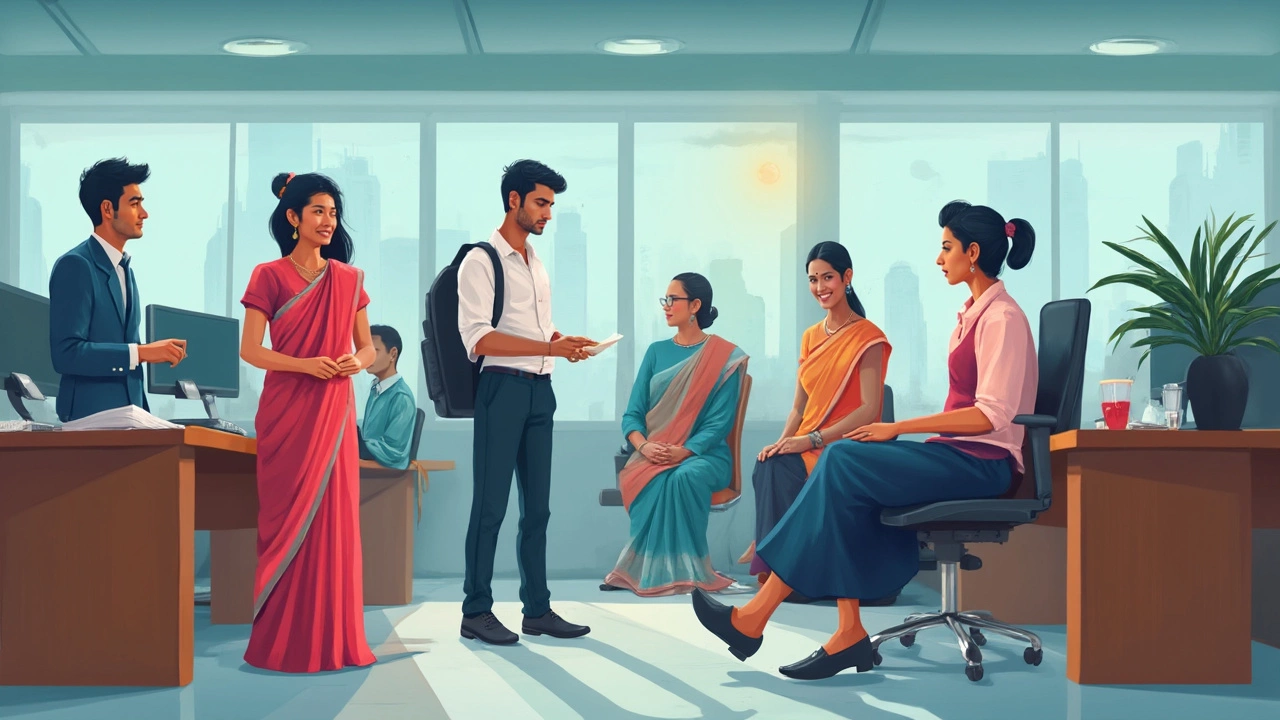How to Stop Feet Hurting at Work: Simple Shoe Hacks That Actually Work

Your feet put up with a lot—a whole day of standing, walking, rushing around, and sometimes squeezing into shoes that look good but feel like medieval torture devices. If you’re counting down the hours until you can finally kick off your work shoes, you’re not alone.
Most foot pain at work comes from a mix of hard floors, bad shoe choices, and not giving your feet a break. Hard concrete and tile don’t absorb any shock, so your heels and arches take the impact. Shoes with flimsy soles, no cushioning, or crammed toe boxes just make it worse. You know that pair you grab because they “kind of work?” That’s probably the main culprit.
But here’s the thing—feet don’t have to hurt all day. Picking the right shoes and making a few easy changes in your routine can turn things around fast. People who walk or stand for a living, like nurses and retail workers, have their own hacks for staying comfy; turns out, you don’t need fancy gear or a doctor’s note.
- Why Your Feet Hurt on the Job
- Finding Shoes That Won’t Destroy Your Day
- Smart Tweaks for Instant Relief
- Foot Care Habits Every Worker Should Know
- When It’s More Than Just Sore Feet
Why Your Feet Hurt on the Job
Turns out, the main reason your feet scream for help at work has nothing to do with your age or shape—it’s really about what you put on your feet and where you stand all day. Over 75% of American workers spend at least 6 hours a day on their feet, and a study from the American Podiatric Medical Association found that half of them deal with sore feet regularly.
Standing or walking on hard floors, like concrete or tile, puts nonstop pressure on your heels, arches, and toes. With each step, your body weight lands right on these small bones and tissues. Floors at work are rarely built for comfort. Add paper-thin soles or stiff shoes, and you multiply the pain. Plus, most people wear the wrong shoe size without realizing it—nearly 60% buy shoes that are too small or don’t fit the shape of their feet.
| Common Causes | Impact |
|---|---|
| Hard floors (concrete/tile) | No shock absorption, heel and arch pain |
| Improper shoe size | Blisters, bunions, cramped toes |
| Lack of cushioning | Sore soles, tired legs |
| Standing still too long | Poor blood flow, foot swelling |
Even if you walk around, standing in one spot (say, at a register or workstation) means your foot muscles never get a good stretch. Blood circulation slows down, so swelling and achy feet kick in. Another biggie? Cheap insoles. If your shoes came with a paper-thin insert, they’re probably offering zero support (and yes, your feet notice).
Some jobs are worse than others. Nurses, teachers, warehouse staff, and retail workers report the highest rates of foot pain. They spend hours upright on the same unforgiving floors, often wearing whatever shoes meet the dress code—not what’s truly comfortable or supportive. If your foot pain shows up every shift, it’s not just you—it’s the job and the shoes most workplaces push you into.
Finding Shoes That Won’t Destroy Your Day
Good work shoes shouldn’t feel like a gamble—there are proven ways to pick a pair that sets you up for comfort. It all starts with fit. Shoes that are too tight mess with circulation and cause blisters, while shoes that are too loose make your feet work harder to stay in place. Some shoe stores now offer digital foot scans, which can help you figure out your actual size. Don’t rely on size alone; width matters just as much. If you're cramming your toes, it’s time to look for a wider fit, not a bigger size.
For long shifts, support is everything. The work shoes you wear need a cushy, yet firm, sole—think memory foam or gel inserts right out of the box. Sneaker brands known for running and athletics, like Brooks or New Balance, are now making options that work with office dress codes. They might look low-key, but the tech inside makes a real difference. You want a shoe that bends at the ball of your foot, not in the middle. Stiff-soled shoes make every step feel harder after just a few hours.
Breathability keeps sweat from turning your shoes into a swamp, especially if you’re wearing them all day. Mesh uppers or shoes that have little vents work better than all-leather or plastic, which trap heat. Closed-toe if your workplace requires it, but you can still look for air flow. Don’t forget to check the insole—if it’s paper-thin, swap it for something orthopedic from the drugstore.
- Shop for shoes in the late afternoon when your feet are a bit swollen—this ensures they’ll fit well at their largest.
- Test shoes by walking around the store. If they don’t feel great right then, they won’t magically get better after hours of use.
- If your job needs special footwear (like steel toes), look for brands with extra padding inside the toe area.
The right shoes don’t have to break the bank. Focus on brands with a return policy—sometimes you only know they hurt after a day on your feet. Listen to your body and trade up if you end up with sore arches or burning heels. The price of comfort is way less than dealing with daily pain.

Smart Tweaks for Instant Relief
When your feet start screaming halfway through your shift, a few quick changes can offer way more relief than you’d expect. No fancy equipment—just smart habits, small add-ons, and things you can do right at your desk or in a break room.
- Switch insoles: Most work shoes come with pretty useless liners. Swapping them for good gel or memory foam insoles can make a huge difference, especially if you’re standing for more than 5 hours a day. Look for ones with arch and heel support.
- Stash a foot roller under your desk: Rolling your feet over something firm (like a spiky massage ball or even a frozen water bottle) boosts blood flow and helps break up tension. Take a minute every couple hours to roll each foot back and forth.
- Alternate your shoes: Changing shoes at lunch gives your feet a break in pressure points and helps shoes dry out, which keeps them smelling better too. Even switching between sneakers and loafers can help.
- Try compression socks: Nurses swear by these for a reason. Compression socks improve circulation and stop swelling, which can ease pain by the end of the day.
- Elevate your feet during breaks: Prop your feet up whenever you can, even if it’s just for five minutes. Elevation reduces swelling fast.
Here’s a quick table with some hacks and how they help:
| Tweak | What It Does | Fast Relief? |
|---|---|---|
| Gel Insoles | Adds cushioning, eases pain from flat shoes | Yes |
| Foot Rolling | Boosts blood flow, relaxes tight muscles | Yes, in under 2 minutes |
| Compression Socks | Reduces swelling, prevents tired legs | By afternoon |
| Elevate Feet | Lowers swelling and pressure fast | Instant (when sitting) |
Don’t ignore your foot pain just because you think it’s part of the job. Even small tweaks can stop that ache from turning into something worse. Try mixing one or two of these into your routine—you’ll feel the payoff by the time you’re clocking out.
Foot Care Habits Every Worker Should Know
If your job keeps you on your feet, daily foot care has to become second nature. Ignoring those aches just makes things worse over time, leading to calluses, blisters, and even heel pain that can make standing unbearable. Here’s how to treat your feet right, starting now.
- Wash and dry feet daily: Easy but often skipped. Sweat plus tight shoes is a recipe for athlete’s foot and smelly socks. Wash with simple soap and water, dry in-between your toes, and swap out damp socks as soon as you can.
- Moisturize: Dry, cracked heels are common for people on their feet all day. Use a plain unscented moisturizer at night. If you notice thick calluses, use a pumice stone a couple of times a week to gently work them down.
- Rotate your shoes: Wearing the same pair every day wears them out faster and traps moisture. Alternate between two solid pairs to help them last longer and stay supportive.
- Stretch regularly: Simple toe, arch, and calf stretches during your breaks help boost circulation and keep your feet from stiffening up. A tennis ball under your arch for a quick roll does wonders mid-shift.
- Clip your nails straight across: Curved nails risk becoming ingrown. Keep them short, but not too short, to avoid pain or infection.
Proper socks are underrated, but they’re your first line of defense against blisters. Go for moisture-wicking fabrics—think technical running socks, not thick cotton ones. If your job’s extra sweaty, bring an extra pair to swap out mid-shift.
To put it all in perspective, check out this quick table on common foot problems and what fixes them fastest at work:
| Problem | Quick Fix |
|---|---|
| Blisters | Cushion pads, swap socks, prevent rubbing |
| Sore arches | Supportive insoles, stretch feet during breaks |
| Heel pain | Cushioned shoes, roll a frozen water bottle under foot |
| Sweaty feet | Change socks, foot powder, breathable shoes |
| Calluses | Pumice stone, moisturizing at night |
Getting into a strong foot care routine does more than just keep the aches away. It keeps you moving and feeling good through your entire shift. Focus on foot pain now, and your future self will thank you by never dodging that after-work walk again.

When It’s More Than Just Sore Feet
Sore feet are annoying, but sometimes pain is a red flag for something bigger. Ignoring certain symptoms can turn a small problem into a major injury. Stuff like numbness, stabbing pain, swollen joints, or color changes are your feet begging for help. If pain messes with your walk or keeps you up at night, it’s time for action.
The most common foot conditions people get at work include plantar fasciitis, bunions, and stress fractures. Plantar fasciitis hits your heel and arch—most folks feel it most when they stand up after sitting. Bunions show up when the big toe pushes against the next toe and the joint gets big and sore. Stress fractures are tiny cracks in your bones, usually from standing for hours or wearing shoes with zero support. If left alone, these can lead to more days off work and even more pain when you do go back.
Check out how these three common foot issues stack up:
| Condition | Main Symptom | Risk at Work | When to See a Doc |
|---|---|---|---|
| Plantar Fasciitis | Heel/arch pain, worst in morning | Hard floors, long shifts | Pain for more than 2 weeks |
| Bunions | Bump at base of big toe | Pointy/narrow shoes | Swelling, trouble fitting shoes |
| Stress Fractures | Sharp pain, swelling | Repetitive impact, poor support | Intensity increases, bruising |
If you notice any of these, don’t just tough it out. Early action can save you from months of pain. Here’s what you should do if things feel off:
- Switch to truly supportive, cushioned shoes.
- Take breaks and prop up your feet, especially if you notice swelling.
- Ice sore spots for 10-15 minutes if things hurt after your shift.
- If your pain lasts more than a week, gets worse, or makes you limp, see a foot doctor (podiatrist).
The surprising part? According to the American Podiatric Medical Association, nearly 77% of Americans have had foot pain, but only about one-third actually went to a doctor. Don’t be part of that crowd. If you want lasting relief from foot pain at work, sometimes you need to listen to your feet—and act before things get serious.